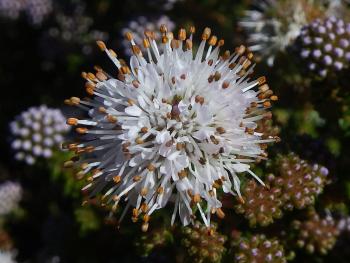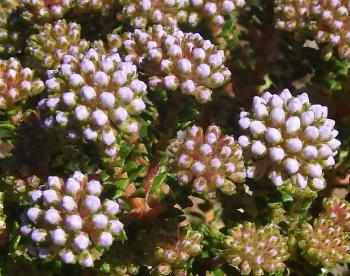Agathosma ciliaris
Agathosma ciliaris (L.) Druce
Family: Rutaceae
Common names: mountain anise buchu (Eng.); bergboegoe (Afr.)
Introduction
This is a hardy, easy-growing, aromatic shrublet, which is suitable for pots and the harsh coasts and mountains in the fynbos.

Description
Description
A dense, rounded shrublet to 450 mm. The leaves are fine with oval, hairy points. White or mauve flowers are borne in terminal clusters, with bracteoles on the flower stalk. Each flower possesses 5 petals, sepals, stamens and staminodes. The flowering period is in winter and spring, from May to December. The ovary and fruits are 3-segmented. Oil glands present in the leaves, as well as the fruits, release an aromatic, aniseed-like fragrance when crushed.

Conservation Status
Status
According to the website http://redlist.sanbi.org, checked on 13 June 2016, the conservation status of this plant is Least Concern (LC). Despite having lost lowland subpopulations to farming and urban development, this species is still widespread and very common.
Distribution and habitat
Distribution description
It is found on coastal flats to lower sandstone slopes and on shale bands in the Western Cape from the Cape Peninsula to Potberg and in the De Hoop Nature Reserve between Bredasdorp and Swellendam.
Derivation of name and historical aspects
History
The genus name Agathosma, is derived from the Greek, agathos, which means ‘good’ and osme, which refers to ‘fragrance’. This indicates the distinctive aromatic foliage so typical of the genus. The specific epithet, ciliaris, is Latin and means ‘fringed with hairs’, referring to the hairs on the leaves and petals.
There are currently 150 species of Agathosma known. Most of them are confined to the Western Cape.
Ecology
Ecology
As with many other buchus, the flowering period sees this species become abuzz with bees. The bees can be observed covering large parts of the plant as they move from one flower to the next.

Uses
Use
No cultural or medicinal uses have been recorded. This species is well suited to cultivation in pots or as a shrub in fynbos gardens.
Growing Agathosma ciliaris
Grow
Sow the seed in autumn in a light, well-draining medium such as coarse river sand or equal parts of sand and compost. Cover seeds with a thin layer of either bark or sand, and then water. Place the seed tray in a covered area that provides enough good light and ventilation. The medium must never be allowed to dry out completely or be overwatered. Germination can take between 4 and 9 weeks, and the appearance of the first 4 true leaves indicate that the seedlings are ready for pricking out. The fine roots are extremely fragile and must be handled with care. Place the potted seedlings in a shady area for 3–4 weeks to harden them off, before placing them in full sun. This will also be a good time to pinch out the growing tips of the seedlings to encourage a more bushy growth habit. Regularly feed the young seedlings with some balanced nutrient products.
This species can also be propagated by vegetative means, by taking cuttings. Prepare cuttings of between 25 and 55 mm, taken from fresh material of the current year’s growth; remove about a third of the foliage and cut them below the node. Dip the cuttings in a rooting hormone and place in trays with a medium consisting of coarse river sand or equal parts of bark and polystyrene. Place the cuttings in a mist-unit with heated benches. Pot the rooted cuttings into a well-drained mix and then move them to a shady area for 2–4 weeks, to harden off. After this, plants can be moved into full sun. After 7–8 months plants can be planted in the garden.
Agathosma ciliaris will thrive in full sun and well-drained, sandy soil, and is best planted amongst other fynbos species. The ideal time for planting is in the rainy season between autumn and winter. This allows plants to have a better chance of establishing themselves in the garden before they have to cope with the harsh, dry conditions in summer. Planting-intervals of 200–300 mm, usually provide ample space to encourage growth. This relatively dense planting is preferred by buchus, since it assists with retaining soil moisture. Provide a good thorough watering in autumn and winter. In summer irrigation should just be moderate; however, plants must never be allowed to dry out completely. Mulching also helps in keeping the roots and soil cool during summer.
Plant this buchu with other fynbos plants such as: Lampranthus amoenus and L. aureus, Leucospermum muirii, Felicia filifolia and F. aethiopica, Coleonema album and Pelargonium cucculatum, P. capitatum and P. betulinum.
References
- Bean, A. & Johns, A. 2005. Stellenbosch to Hermanus South African wild flower guide 5. Botanical Society of South Africa, Cape Town.
- Goldblatt, P. & Manning, J. 2000. Cape Plants. A conspectus of the Cape flora of South Africa. Strelitzia 9. National Botanical Institute, Pretoria & Missouri Botanical Garden, Missouri.
- Gould, M. 1992. The buchus: cultivation and propagation. National Botanical Institute, Cape Town.
- Powrie, F. 1998. Grow South African Plants. A gardener's companion to indigenous plants. National Botanical Institute, Cape Town.
- Smith, C.A. 1966. Common names of South African plants. Memoirs of the Botanical Survey of South Africa No. 35. Government Printer, Pretoria.
- Stearn, W. 2002. Stearn's dictionary of plant names for gardeners. Timber Press, Portland, Oregon.
Credits
Roger Oliver
Kirstenbosch National Botanical Garden
July 2016
Plant Attributes:
Plant Type: Shrub
SA Distribution: Western Cape
Soil type: Sandy, Loam
Flowering season: Spring, Winter
PH: Acid
Flower colour: White, Mauve/Lilac
Aspect: Full Sun
Gardening skill: Easy
Special Features:
Horticultural zones







Rate this article
Article well written and informative
Rate this plant
Is this an interesting plant?
Login to add your Comment
Back to topNot registered yet? Click here to register.